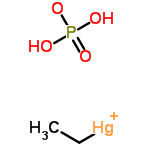-
Name
Ethylmercury phosphate
- EINECS
- CAS No. 2235-25-8
- Density g/cm3
- Solubility
- Melting Point 179-180 °C
- Formula C2H5 Hg O4 P . 2 H
- Boiling Point 158°Cat760mmHg
- Molecular Weight 326.639
- Flash Point °C
- Transport Information
- Appearance
- Safety Human poison by ingestion. Experimental poison by subcutaneous route. An experimental teratogen. When heated to decomposition it emits toxic fumes of POx and Hg. See also MERCURY COMPOUNDS, INORGANIC; MERCURY COMPOUNDS, ORGANIC and PHOSPHATES.
- Risk Codes
-
Molecular Structure
- Hazard Symbols
- Synonyms Ethylmercuryphosphate (6CI); Mercurate(2-), ethyl[phosphato(3-)-O]-, dihydrogen; Mercury,(dihydrogen phosphato)ethyl- (7CI,8CI); Phosphoric acid, mercury complex;Ceresan NI; EMP; Ethylmercuric phosphate; Fusariol universal; Granosan M;Lignasan; Ruberon granule
- PSA 76.57000
- LogP 0.53140
Ethylmercuric phosphate Chemical Properties
IUPAC Name: dihydrogen phosphate;ethylmercury(1+)
Synonyms of Ethylmercuric phosphate (CAS NO.2235-25-8): Caswell No. 452 ; Ceresan NI ; EINECS 218-790-2 ; EMP ; EPA Pesticide Chemical Code 041505 ; Ethyl mercuric phosphate ; Ethyl mercury phosphate ; Ethylmerkuridihydrogenfosfat ; Ethylmerkuridihydrogenfosfat [Czech] ; Fusariol universal ; Granosan M ; HSDB 6424 ; Lignasan ; N. I. ceresan ; New Improved Ceresan ; New Improved Granosan ; Ruberon granule ; Soilsin; Mercurate(2-), ethyl(phosphato(3-)-O)-, dihydrogen (9CI) ; Mercurate(2-), ethyl(phosphato(3-)-kappaO)-, dihydrogen ; Mercury, (dihydrogen phosphato)ethyl- ; Tris(ethylmercury) phosphate
Molecular Formula: C2H7HgO4P
Molecular Weight : 326.6383
Boiling Point: 158 °C at 760 mmHg
Vapour Pressure: 1.41 mmHg at 25°C
Molecular Structure :
Ethylmercuric phosphate Uses
Ethylmercuric phosphate (CAS NO.2235-25-8) can make pesticides .
Ethylmercuric phosphate Toxicity Data With Reference
| Organism | Test Type | Route | Reported Dose (Normalized Dose) | Effect | Source |
|---|---|---|---|---|---|
| human | LDLo | oral | 8614ug/kg/13W (8.614mg/kg) | Toxicology. Vol. 6, Pg. 155, 1976. | |
| mouse | LD50 | oral | 48mg/kg (48mg/kg) | BEHAVIORAL: ALTERED SLEEP TIME (INCLUDING CHANGE IN RIGHTING REFLEX) LUNGS, THORAX, OR RESPIRATION: DYSPNEA BEHAVIORAL: SOMNOLENCE (GENERAL DEPRESSED ACTIVITY) | Nippon Yakurigaku Zasshi. Japanese Journal of Pharmacology. Vol. 59, Pg. 452, 1963. |
| mouse | LD50 | subcutaneous | 76mg/kg (76mg/kg) | Proceedings of the Congenital Anomalies Research Association of Japan. Vol. 7, Pg. 53, 1967. | |
| rat | LD50 | oral | 48mg/kg (48mg/kg) | BEHAVIORAL: ALTERED SLEEP TIME (INCLUDING CHANGE IN RIGHTING REFLEX) BEHAVIORAL: SOMNOLENCE (GENERAL DEPRESSED ACTIVITY) BEHAVIORAL: ATAXIA | Nippon Yakurigaku Zasshi. Japanese Journal of Pharmacology. Vol. 59, Pg. 452, 1963. |
Ethylmercuric phosphate Consensus Reports
Mercury and its compounds are on the Community Right-To-Know List.
Ethylmercuric phosphate Safety Profile
RIDADR: 2025
HazardClass: 6.1(a)
PackingGroup: II
Ethylmercuric phosphate (CAS NO.2235-25-8) is human poison by ingestion. Experimental poison by subcutaneous route. An experimental teratogen. When heated to decomposition it emits toxic fumes of POx and Hg. See also MERCURY COMPOUNDS, INORGANIC; MERCURY COMPOUNDS, ORGANIC and PHOSPHATES;
Ethylmercuric phosphate Standards and Recommendations
OSHA PEL: TWA 0.01 mg(Hg)/m3; STEL 0.03 mg/m3 (skin)
ACGIH TLV: TWA 0.01 mg(Hg)/m3; BEI: 35 µg/g creatinine total inorganic mercury in urine preshift; 15 µg/g creatinine total inorganic mercury in blood at end of shift at end of workweek.
DFG MAK: Confirmed Animal Carcinogen with Unknown Relevance to Humans
NIOSH REL: (Mercury, Organo) TWA 0.01 mg/m3; STEL 0.03 mg/m3 (skin)
About|Contact|Cas|Product Name|Molecular|Country|Encyclopedia
Message|New Cas|MSDS|Service|Advertisement|CAS DataBase|Article Data|Manufacturers | Chemical Catalog
©2008 LookChem.com,License: ICP
NO.:Zhejiang16009103
complaints:service@lookchem.com Desktop View